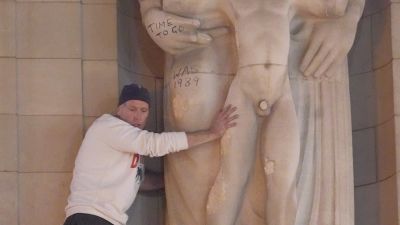BBC defends decision not to remove defaced statue by Eric Gill at London HQ

The BBC said a statue outside its central London headquarters will stay there after it was defaced by a protestor with a hammer.
The depiction of Prospero and Ariel by sculptor Eric Gill has been on display above a door at Broadcasting House since 1933.
A man was arrested on suspicion of criminal damage on Wednesday after emergency services were called.
A statement from the BBC said: "The statue at the front of old Broadcasting House is a representation of Prospero and Ariel from Shakespeare’s The Tempest. Prospero is shown sending Ariel out into the world.
"When the statue was commissioned, Ariel – as the spirit of the air – was seen as an appropriate symbol for the new dawn of broadcasting.
"The BBC doesn’t condone the views or actions of Eric Gill. Clearly there are debates about whether you can separate the work of an artist from the art itself.
"We think the right thing to do is for people to have those discussions. We don’t think the right approach is to damage the artwork itself."
Why is Eric Gill statue controversial?
Gill was among the most prominent sculptors of the 20th century until his death in 1940. His diaries, published much later, detailed the sexual abuse of his daughters. A biography on the Tate museum website said: "His religious views and subject matter contrast with his sexual behaviour, including his erotic art, and (as mentioned in his own diaries) his extramarital affairs and sexual abuse of his daughters, sisters and dog."
Nearly 2,500 people have previously signed a petition demanding the removal of the sculpture on the website of political activist group 38 Degrees.
The incident came a week after a jury cleared four people of criminal damage after they pulled down the statue of slave trader Edward Colston.
The bronze memorial to the 17th century figure was pulled down during a Black Lives Matter protest in Bristol on June 7 2020, before being rolled into the water, and those responsible were acquitted on January 5 following an 11-day trial.